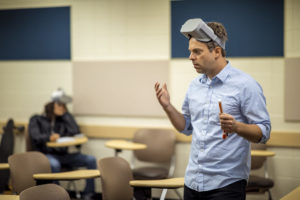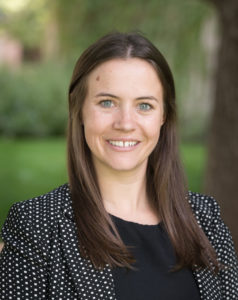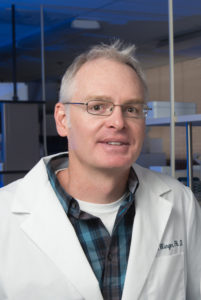In this pre-pandemic photo, Erica Suchman teaches a virology lab. Now, much of her teaching is in a virtual setting. (Justin VanAlstyne/CVMBS photo)
Training the next generation of scientists during a pandemic: “Now more important than ever”
By Sarah Ryan
This fall, first-year students in the College of Veterinary Medicine and Biomedical Sciences will have a once-in-a-lifetime learning experience. They are at once the first freshman class in the 21st century to attend college during a global pandemic, and the inaugural cohort of the College’s new major.
“It’s now more important than ever that we’re training the next generation of scientists to be prepared for the next pandemic,” said Josh Schaeffer, assistant professor of occupational and environmental health. With the guidance of Sandra Quackenbush, associate dean for academic affairs, Schaeffer and colleagues across the College, including Judy Heiderscheidt, Erica Suchman, and Jennifer McLean, spent three years planning and implementing a radical new approach to undergraduate education.

The new program features a B.S. in Biomedical Sciences with three concentrations—microbiology and infectious diseases, anatomy and physiology, and environmental public health—and an innovative first-year seminar. The cohort of 150 students will study the pandemic in class while they are adjusting to the “new normal” of face masks, social distancing, and hybrid learning.
“It’s a great time to pull from current events,” Schaeffer said. “We’ll integrate SARS and COVID-19 into lectures and case studies to reinforce the fundamental principles they’re learning. We can explore how we approach these questions from each concentration and how do we work together across disciplines.”
Roadmap for success
The class, VMBS 100, is designed to spark students’ natural curiosity and provide a roadmap for success in their undergraduate career. Students will work in small groups to tackle case studies in which they analyze real-world challenges from the perspectives of the three concentrations. In the SARS and COVID-19 case study, students will observe the concentrations in action by examining the microbiological origins, the biomedical effects, and the public health implications of the disease.
The team-taught course includes faculty, graduate teaching assistants, and undergraduate learning assistants from every concentration, so there will be ample human resources to supplement learning and build community.

“The majority of our undergrad students are pre-med or pre-vet when they begin at CSU, but their interests and goals shift over time,” said academic advisor Karli Hansen, who coordinates the first-year seminar and advises majors until they declare a concentration.
Hansen looks forward to helping students explore their interests and goals while breaking down stereotypes and expectations about the disciplines and careers. Once they find the best fit, they will transition to an adviser in their concentration. The program embraces flexibility and discovery in the student experience, and prepares students to lead and collaborate in careers that are constantly evolving.
Building equity and access
Microbiology professor and University Distinguished Teaching Scholar Erica Suchman has been an advocate for undergraduate education since she began teaching at CSU in 1995. “The old model of lectures and exams worked well for a certain group of people who had access to certain resources, like a network of people to explain how the system works. It was very exclusive and it exacerbated inequality,” Suchman said. “I knew we could do better.”

Suchman helped plan VMBS 100 with the goal of teaching students to think like scientists through the use of problem-based learning and peer-teaching. While they’re learning to think like scientists, the first-years will also learn how to be successful college students (see sidebar).
“We’re not making any assumptions about our students’ preparation. Instead, we’re building a foundation that puts all students on equal footing,” said Hansen. “We’re breaking down hierarchies by explicitly discussing how to find mentors, how to talk to faculty, how to network, how to challenge the system, how to access accommodations and advocate for themselves. These are all tools that our students—especially first-generation students and students in traditionally marginalized populations—need to succeed in a system that wasn’t built for them.”
Online learning is the new normal
Due to COVID-19, the first-year seminar will take place online, but the VMBS 100 team has responded rapidly to change by completing a course in designing for active online learning, utilizing more undergraduate learning assistants and graduate teaching assistants, and adapting problem-based learning to the online platform.

“VMBS 100 is going to be an amazing experience for first-year students in the BMS major, with 150 students all in the same classroom networking, building community, and thoughtfully choosing a concentration,” said Quint Winger, associate professor and director of undergraduate programs in the Department of Biomedical Sciences. “And while COVID-19 has moved this gathering of students online, it will be an equally engaging experience to help biomedical sciences students navigate their first year.”
Students will also have expanded access to advising, faculty, and their peers, with regular check-ins, drop-in office hours, and Zoom, we have even more ways for students to connect with each other and faculty. Additionally, waitlisted students can now access the online modules.
“While this is going to be a unique semester, we remain committed to teaching excellency and we’ll be ready for online, hybrid, and face-to-face,” Schaeffer said. “We’re putting together an exciting and rigorous program and students can come into the College knowing they’re going to get the education they want.”
The Struggle is Real: Science-based strategies improve learning outcomes
“We don’t understand learnings as well as we think we do because a lot of learning is counterintuitive,” says Matthew Rhodes, a psychology professor at Colorado State University.
 Rhodes co-authored A Guide to Effective Studying and Learning: Practical Strategies from the Science of Learning with Anne Cleary and Edward DeLosh. The trio studies and teaches effective learning strategies and collaborates with CSU’s Center for the Analytics of Learning and Teaching. They aim to help university students become effective self-regulators or individuals who know how to learn independently.
Rhodes co-authored A Guide to Effective Studying and Learning: Practical Strategies from the Science of Learning with Anne Cleary and Edward DeLosh. The trio studies and teaches effective learning strategies and collaborates with CSU’s Center for the Analytics of Learning and Teaching. They aim to help university students become effective self-regulators or individuals who know how to learn independently.
“Strategies that feel effective to us while we’re in the process of doing them—like highlighting, rereading, or cramming—are often the least effective for our long-term learning,” Cleary says. “And strategies that feel difficult or like they’re having no impact while we’re doing them are often the most impactful over the long term.”
Ready to throw up your hands—and your highlighters—in frustration? No need. Effective learning strategies might not be intuitive, but they are easy to understand and adopt. Cleary and Rhodes call them “The Big Three”: elaboration, self-testing, and spacing. Elaboration means providing your own thoughts, making connections between prior knowledge and new material, and asking questions. Self-testing is any formal or informal act of questioning one’s understanding and retention. Spacing involves distributing learning and assessment over time. For example, preparing for an exam one hour a day for five days, instead of five hours in one day.
“We’re much more efficient when we distribute learning over time, and that holds not just for retention of information but for every other type of learning as well, including understanding difficult concepts and coming up with creative ideas, and that’s probably due to sleep,” Cleary says. “When you sleep, there’s a lot going on in your brain, not just consolidating memories but also making connections. As new ideas encounter older, more established ideas, they prime your brain to be more apt to detect a new insight or relationship or solve a problem.”
The faculty who designed VMBS 100 selected A Guide to Effective Studying and Learning for the course textbook so they could help students succeed in college by using science-based learning strategies. The book’s recommendations also shaped the structure of the seminar, which integrates The Big Three in class activities and assignments. Students can expect to thrive with activities like brain dumps, pair-and-share, and group testing.
Rhodes adds that the single best thing a student can do to improve learning outcomes is to get lots of sleep. “If I could wave a magic wand, I would get all the students more sleep,” Rhodes says. But remember, to get the maximal benefit from sleep, distribute your learning across time so that you can benefit from letting your brain sleep on it!